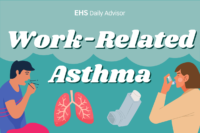Highlighting the building blocks of safety culture and essential information that any EHS professional should know.
Back to Basics is a weekly feature that highlights important but possibly overlooked information that any EHS professional should know. This week, we examine the difference between cleaning, disinfecting, and sanitizing. It’s important to properly clean, disinfect, and sanitize to make buildings healthy. There is some confusion among the three terms, but it’s important to […]
Oil and gas industry workers face all kinds of hazards during all the different industrial processes they execute in order to drill and service a well. Here’s what you need to know about oil and gas industry hazards.
Back to Basics is a weekly feature that highlights important but possibly overlooked information that any EHS professional should know. This week, we examine the hazards associated with oil and gas extraction, and OSHA’s recommendations for oil and gas safety. Oil and gas industry workers face all kinds of hazards during all the different industrial […]
Working with machinery and moving machine parts is common in many workplaces, and according to OSHA, it has the potential to cause serious injuries amongst employees such as crushed fingers or hands, amputations, burns, or blindness. Here’s what you need to know about machine guarding.
Back to Basics is a weekly feature that highlights important but possibly overlooked information that any EHS professional should know. This week, we examine OSHA’s standards for machine guarding in the general, construction, maritime, and agricultural industries. Working with machinery and moving machine parts is common in many workplaces, and according to OSHA, it has […]
Workers are exposed to hazardous energy in a number of different industries, especially during equipment and machinery maintenance and servicing. Here’s what you need to know about lockout/tagout.
Back to Basics is a weekly feature that highlights important but possibly overlooked information that any EHS professional should know. This week, we examine lockout/tagout and OSHA’s recommendations for controlling hazardous energy. Workers are exposed to hazardous energy in a number of different industries, especially during equipment and machinery maintenance and servicing. According to OSHA, […]
Asthma is a lung condition in which the airways become narrow and inflamed, and it is accompanied by episodes of wheezing, chest tightness, shortness of breath, and coughing. According to the National Institute for Occupational Safety and Health (NIOSH), work-related asthma is asthma triggered by an exposure at work. There are over 300 known or suspected substances […]
Back to Basics is a weekly feature that highlights important but possibly overlooked information that any EHS professional should know. This week, we examine work-related asthma and NIOSH’s recommendations for prevention. Asthma is a lung condition in which the airways become narrow and inflamed, and it is accompanied by episodes of wheezing, chest tightness, shortness […]
According to OSHA, nail technicians face a wide variety of health hazards every day at work. OSHA has several recommendations for nail technicians to help keep them safe when dealing with the three main types of hazards: chemical, ergonomic, and biological hazards. Here’s what you need to know about nail technician safety. Check out our Back to Basics: […]










